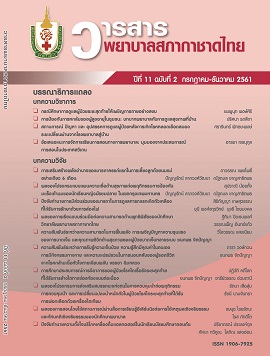ปัจจัยทำนายความตั้งใจบริโภคเครื่องดื่มแอลกอฮอล์ในนักเรียนมัธยมศึกษาตอนต้น
คำสำคัญ:
ความตั้งใจบริโภคเครื่องดื่มแอลกอฮอล์, ทัศนคติต่อการบริโภคเครื่องดื่มแอลกอฮอล์, บรรทัดฐานทางสังคมในการบริโภคเครื่องดื่มแอลกอฮอล์, การรับรู้ความสามารถในการควบคุมพฤติกรรมบริโภคเครื่องดื่มแอลกอฮอล์, นักเรียนชั้นมัธยมศึกษาตอนต้นบทคัดย่อ
การวิจัยครั้งนี้เป็นการวิจัยเชิงพรรณนา เพื่อศึกษาปัจจัยทำนายความตั้งใจบริโภคเครื่องดื่มแอลกอฮอล์ในนักเรียนมัธยมศึกษาตอนต้น กลุ่มตัวอย่างเป็นนักเรียนชั้นมัธยมศึกษาปีที่ 1-3 ของโรงเรียนมัธยมศึกษาของจังหวัดหนึ่งในภาคใต้ ประเทศไทย จำนวน 658 คน เครื่องมือที่ใช้ในการวิจัยครั้งนี้ ประกอบด้วย 5 ส่วน ได้แก่ แบบสอบถามข้อมูลทั่วไป แบบสอบถามเกี่ยวกับทัศนคติต่อการบริโภคเครื่องดื่มแอลกอฮอล์ แบบสอบถามเกี่ยวกับบรรทัดฐานทางสังคมในการบริโภคเครื่องดื่มแอลกอฮอล์ แบบสอบถามเกี่ยวกับการรับรู้ความสามารถในการควบคุมพฤติกรรมการบริโภคเครื่องดื่มแอลกอฮอล์ และแบบสอบถามเกี่ยวกับความตั้งใจบริโภคเครื่องดื่มแอลกอฮอล์ คุณภาพเครื่องมือตรวจสอบความตรงด้านเนื้อหาจากผู้เชี่ยวชาญ จำนวน 5 ท่าน ได้ค่าดัชนีความตรงตามเนื้อหา (CVI) เท่ากับ 0.75 – 1.00 และผ่านการทดสอบความเที่ยง (Reliability) กับนักเรียนมัธยมศึกษาตอนต้น จำนวน 30 คน ได้ค่าสัมประสิทธิ์อัลฟาของครอนบาค เท่ากับ 0.74-0.97 วิเคราะห์ข้อมูลโดยใช้สถิติบรรยาย และสถิติการถดถอยโลจิสติค
ผลการวิจัยพบว่า ทัศนคติต่อการบริโภคเครื่องดื่มแอลกอฮอล์ บรรทัดฐานทางสังคมในการบริโภคเครื่องดื่มแอลกอฮอล์ และการรับรู้ความสามารถในการควบคุมพฤติกรรมบริโภคเครื่องดื่มแอลกอฮอล์ สามารถร่วมกันอธิบายความแปรปรวนของความตั้งใจที่จะบริโภคเครื่องดื่มแอลกอฮอล์ในนักเรียนมัธยมศึกษาตอนต้นได้ร้อยละ 38.8 โดยทัศนคติต่อการบริโภคเครื่องดื่มแอลกอฮอล์ และบรรทัดฐานทางสังคมในการบริโภคเครื่องดื่มแอลกอฮอล์ เป็นปัจจัยที่สามารถทำนายความตั้งใจบริโภคเครื่องดื่มแอลกอฮอล์ในนักเรียนมัธยมศึกษาตอนต้นได้อย่างมีนัยสำคัญทางสถิติที่ระดับ .001 โดยที่การมีคะแนนทัศนคติต่อการบริโภคเครื่องดื่มแอลกอฮอล์เพิ่มขึ้น 1 คะแนน เพิ่มโอกาสที่นักเรียนจะมีความตั้งใจบริโภคเครื่องดื่มแอลกอฮอล์ 1.02 เท่า (OR = 1.023, 95% CI = 1.012-1.034, p < .001) การมีคะแนนบรรทัดฐานทางสังคมในการบริโภคเครื่องดื่มแอลกอฮอล์ลดลง 1 คะแนน เพิ่มโอกาสที่นักเรียนจะมีความตั้งใจบริโภคเครื่องดื่มแอลกอฮอล์ .97 เท่า (OR = .968, 95% CI = .960-.976, p < .001) ผลการวิจัยครั้งนี้ให้ข้อมูลที่สำคัญในการนำไปวางแผนป้องกันพฤติกรรมบริโภคเครื่องดื่มแอลกอฮอล์ในนักเรียนมัธยมศึกษาตอนต้นต่อไป
เอกสารอ้างอิง
2. World Health Organization. Adolescents: health risks and solutions [Internet]. 2016 [cited 2017 Jan 10]. Available from: http://www.who.int/mediacentre/factsheets/fs345/en/
3. World Health Organization. Global status report on alcohol and health [Internet]. 2014 [cited 2016 Mar 1]. Available from http://www.who.int/substance_abuse/publications/global_alcohol_report/msb_gsr_2014_1.pdf?ua=1
4. World Health Organization. Global school-based student health survey: Thailand public 2015 fact sheet [Internet]. 2015 [cited 2016 Oct 11]. Available from: http://www.who.int/chp/gshs/2015-Thailand-GSHS-Fact-Sheet.pdf
5. National Statistical Office of Thailand. Survey of smoking and alcohol drinking behaviors of the Thai population in 2011. Bangkok: National Statistical Office of Thailand; 2012. (in Thai)
6. Asanongkornchai S, Meokthong A, Inthanon T. Behavioral surveillance alcohol consumption and health behavior of high school students in Thailand. Nonthaburi: Center for Alcohol Studies; 2011. (in Thai)
7. National Statistical Office of Thailand. Survey of smoking and alcohol drinking behaviors of the Thai population in 2011. Bangkok: National Statistical Office of Thailand; 2014. (in Thai)
8. Office of International Health Policy Development. Burden of disease and injury of Thai population in 2014. Nonthaburi: The Grafico systems; 2014. (in Thai)
9. Pichainarong N, Chaveepojnkamjorn W. Alcohol use and sexual-risk behaviors among female youths: a cross-sectional survey in central Thailand. MSU Journals 2014;34(2):171-9. (in Thai)
10. Center for Alcohol Studies. The 4th National alcohol conference "stop the alcohol crisis with the Law". Nonthaburi: The Grafico systems; 2008. (in Thai)
11. Thai Health Promotion Foundation. Violence situation in teenage couples [Internet]. 2014 [cited 2016 Oct 11]. Available from: http://www.thaihealth.or.th (in Thai)
12. Chaisong S, Paldeesetkul K, Thammarangsee T. Provincial alcohol report 2011. Nonthaburi: The Grafico systems; 2013. (in Thai)
13. Kongkaew C, Rujanawong W, Nathaphong P, Korsuwansiri W, Nitsamer P, Phathichon P, et al. Wrongdoing reduction strategy in underage drinking. Bangkok: Department of juvenile observation and protection; 2007. (in Thai)
14. Rattanachotipanich T, et al. Cost of alcohol consumption in Thailand 2010. Nonthaburi: Center for Alcohol Studies; 2012. (in Thai)
15. Perngchaer K. Predicting factors of alcohol consumption among youth in Nakhon Pathom Province [Master of Science (Industrial and Organizational Psychology)]. Bangkok: Kasetsart University; 2012. (in Thai)
16. Kawchim P, Saetung D. Causal factors influencing student drinking behavior of university students: a case study of a public university. UMT Poly Journal 2012;9(1):1-13. (in Thai)
17. Sunthorn P. Prevalence and factors influenced to alcohol consumption behavior of high school students in Li district Lamphun province. Lanna Public Health Journal 2013;9(1):35-48. (in Thai)
18. Buasorn R, Rutchadapunnathikul C. Factors related to the alcohol consumption behavior of bachelor degree students in the Bangkok area. Ramathibodi Nursing Journal 2012;18(2): 259-71. (in Thai)
19. Hemayard A, Yodnil S. Factors related to alcohol drinking among female high school students in Amphur Khowkitchakoot Chanthaburi province. Journal of Education and Social Development 2012;8(1):115-28. (in Thai)
20. Bahr SJ, Hoffmann JP. Parenting style, religiosity, peers, and adolescent heavy drinking. J Stud Alcohol Drugs 2010;71(4):539-43.
21. Kheaw-on M, Sangon S, Nintachan P. Factors relating to drinking behavior in navy non-commissioned officer students. The Journal of Psychiatric Nursing and Mental Health 2016; 0(3):36-51. (in Thai)
22. Theerasiriroj T. The Factors influencing intention of alcohol consumption behavior amongst senior high school students [Master Thesis of Nursing Science]. Nakhon Pathom: Christian University; 2011. (in Thai)
23. Petchsuk R. Factors influencing the intention to alcohol consumption of high school students in Bangkok. Thai Journal of Nursing 2013;62(4):20-6. (in Thai)
24. Cooke R, Dahdah M, Norman P, French DP. How well does the theory of planned behaviour predict alcohol consumption? A systematic review and meta-analysis. Health Psychol Rev 2016;10(2):148-67.
25. Huchting K, Lac A, LaBrie JW. An application of the theory of planned behavior to sorority alcohol consumption. Addict Behav 2008;33(4):538-51.
26. Marcoux BC, Shope JT. Application of the theory of planned behavior to adolescent use and misuse of alcohol. Health Education Research Theory Practice 1997;12(3):323-31.
27. Norman P, Bennett P, Lewis H. Understanding binge drinking among young people: an application of the theory of planned behaviour. Health Education Research Theory Practice 1998;13(2):163-69.
28. Phuphaibul R, Nuntawan C, Loveland-Cherry C. Predicting alcohol drinking intention and behavior of Thai adolescents. Pacific Rim Int J Nur Res 2011;15(1):28-38.
29. Zanten RV. Drink choice: factors influencing the intention to drink wine. International Journal of Wine Marketing 2005;17(2):49-61.
30. Ajzen I. Construction a TpB questionnaire: conceptual and methodological considerations [Internet]. 2006 [cited 2016 Mar 1]. Available from: http://people.umass.edu/ajzen/pdf/tpb.Measurement.pdf
31. Park HA. An Introduction to Logistic Regression: from Basic Concepts to Interpretation with Particular Attention to Nursing Domain. J Korean Acad Nurs 2013;43(2):154-64.
32. Jaikumpan N. The study of factors Predicting Intention of alcohol consumption behavior in secondary school students in SansaiLuang Amphur Sansai Chiang Mai province [Master Thesis of Public Health]. Phayao: University of Phayao; 2012. (in Thai)
33. Cohen J. Statistical power analysis for the behavioral sciences. New York: Routledge Academic; 1988.
34. Thavorncharoensarp M, Thiwattanaon Y, Chaikradkeaw U, Lertpitakpong C, Yothasamutt J, Thitiboonsuwan, et al. A study on social, health and economic conscienceless of alcohol consumption in Thailand. Nonthaburi: Health Systems Research Institute (HSRI); 2008. (in Thai)
35. Waleewong O, Chaisong S, Thammarungsri T. Influence of parental norms and behaviours on youth drinking in Thailand. Bangkok: Center for Alcohol Studies; 2010. (in Thai)
36. Samoraphorm C. Causal factors and prevention guideline of alcohol drinking behavior among adolescent students in north-eastern Thailand [Doctor of Philosophy Thesis]. Chonburi: Burapha University; 2011. (in Thai)
ดาวน์โหลด
เผยแพร่แล้ว
ฉบับ
ประเภทบทความ
สัญญาอนุญาต
เนื้อหาบทความหรือข้อคิดเห็นต่างๆ ในวารสารพยาบาลสภากาชาดไทยนี้ เป็นความคิดเห็นของผู้เขียนบทความ ไม่ใช่ความเห็นของกองบรรณาธิการ หรือสถาบันการพยาบาลศรีสวรินทิรา สภากาชาดไทย






